Table of Contents
Preface
1 Introduction
1.1 Architecture
1.2 Flexible Clock System
1.3 Embedded Emulation
1.4 Address Space
1.4.1 Flash/ROM
1.4.2 RAM
1.4.3 Peripheral Modules
1.4.4 Special Function Registers (SFRs)
1.4.5 Memory Organization
1.5 MSP430x2xx Family Enhancements
2 System Resets, Interrupts, and Operating Modes
2.1 System Reset and Initialization
2.1.1 Brownout Reset (BOR)
2.1.2 Device Initial Conditions After System Reset
2.1.2.1 Software Initialization
2.2 Interrupts
2.2.1 (Non)-Maskable Interrupts (NMI)
2.2.1.1 Reset/NMI Pin
2.2.1.2 Flash Access Violation
2.2.1.3 Oscillator Fault
2.2.1.4 Example of an NMI Interrupt Handler
2.2.2 Maskable Interrupts
2.2.3 Interrupt Processing
2.2.3.1 Interrupt Acceptance
2.2.3.2 Return From Interrupt
2.2.3.3 Interrupt Nesting
2.2.4 Interrupt Vectors
2.3 Operating Modes
2.3.1 Entering and Exiting Low-Power Modes
2.4 Principles for Low-Power Applications
2.5 Connection of Unused Pins
3 CPU
3.1 CPU Introduction
3.2 CPU Registers
3.2.1 Program Counter (PC)
3.2.2 Stack Pointer (SP)
3.2.3 Status Register (SR)
3.2.4 Constant Generator Registers CG1 and CG2
3.2.4.1 Constant Generator - Expanded Instruction Set
3.2.5 General-Purpose Registers R4 to R15
3.3 Addressing Modes
3.3.1 Register Mode
3.3.2 Indexed Mode
3.3.3 Symbolic Mode
3.3.4 Absolute Mode
3.3.5 Indirect Register Mode
3.3.6 Indirect Autoincrement Mode
3.3.7 Immediate Mode
3.4 Instruction Set
3.4.1 Double-Operand (Format I) Instructions
3.4.2 Single-Operand (Format II) Instructions
3.4.3 Jumps
3.4.4 Instruction Cycles and Lengths
3.4.4.1 Interrupt and Reset Cycles
3.4.4.2 Format-II (Single Operand) Instruction Cycles and Lengths
3.4.4.3 Format-III (Jump) Instruction Cycles and Lengths
3.4.4.4 Format-I (Double Operand) Instruction Cycles and Lengths
3.4.5 Instruction Set Description
3.4.6 Instruction Set Details
3.4.6.1 ADC
3.4.6.2 ADD
3.4.6.3 ADDC
3.4.6.4 AND
3.4.6.5 BIC
3.4.6.6 BIS
3.4.6.7 BIT
3.4.6.8 BR, BRANCH
3.4.6.9 CALL
3.4.6.10 CLR
3.4.6.11 CLRC
3.4.6.12 CLRN
3.4.6.13 CLRZ
3.4.6.14 CMP
3.4.6.15 DADC
3.4.6.16 DADD
3.4.6.17 DEC
3.4.6.18 DECD
3.4.6.19 DINT
3.4.6.20 EINT
3.4.6.21 INC
3.4.6.22 INCD
3.4.6.23 INV
3.4.6.24 JC, JHS
3.4.6.25 JEQ, JZ
3.4.6.26 JGE
3.4.6.27 JL
3.4.6.28 JMP
3.4.6.29 JN
3.4.6.30 JNC, JLO
3.4.6.31 JNE, JNZ
3.4.6.32 MOV
3.4.6.33 NOP
3.4.6.34 POP
3.4.6.35 PUSH
3.4.6.36 RET
3.4.6.37 RETI
3.4.6.38 RLA
3.4.6.39 RLC
3.4.6.40 RRA
3.4.6.41 RRC
3.4.6.42 SBC
3.4.6.43 SETC
3.4.6.44 SETN
3.4.6.45 SETZ
3.4.6.46 SUB
3.4.6.47 SUBC, SBB
3.4.6.48 SWPB
3.4.6.49 SXT
3.4.6.50 TST
3.4.6.51 XOR
4 CPUX
4.1 CPU Introduction
4.2 Interrupts
4.3 CPU Registers
4.3.1 Program Counter (PC)
4.3.2 Stack Pointer (SP)
4.3.3 Status Register (SR)
4.3.4 Constant Generator Registers (CG1 and CG2)
4.3.4.1 Constant Generator – Expanded Instruction Set
4.3.5 General-Purpose Registers (R4 to R15)
4.4 Addressing Modes
4.4.1 Register Mode
4.4.2 Indexed Mode
4.4.2.1 Indexed Mode in Lower 64-KB Memory
4.4.2.2 MSP430 Instruction With Indexed Mode in Upper Memory
4.4.2.3 MSP430X Instruction With Indexed Mode
4.4.3 Symbolic Mode
4.4.3.1 Symbolic Mode in Lower 64KB
4.4.3.2 MSP430 Instruction With Symbolic Mode in Upper Memory
4.4.3.3 MSP430X Instruction With Symbolic Mode
4.4.4 Absolute Mode
4.4.4.1 Absolute Mode in Lower 64KB
4.4.4.2 MSP430X Instruction With Absolute Mode
4.4.5 Indirect Register Mode
4.4.6 Indirect Autoincrement Mode
4.4.7 Immediate Mode
4.4.7.1 MSP430 Instructions With Immediate Mode
4.4.7.2 MSP430X Instructions With Immediate Mode
4.5 MSP430 and MSP430X Instructions
4.5.1 MSP430 Instructions
4.5.1.1 MSP430 Double-Operand (Format I) Instructions
4.5.1.2 MSP430 Single-Operand (Format II) Instructions
4.5.1.3 Jump Instructions
4.5.1.4 Emulated Instructions
4.5.1.5 MSP430 Instruction Execution
4.5.1.5.1 Instruction Cycles and Length for Interrupt, Reset, and Subroutines
4.5.1.5.2 Format II (Single-Operand) Instruction Cycles and Lengths
4.5.1.5.3 Jump Instructions Cycles and Lengths
4.5.1.5.4 Format I (Double-Operand) Instruction Cycles and Lengths
4.5.2 MSP430X Extended Instructions
4.5.2.1 Register Mode Extension Word
4.5.2.2 Non-Register Mode Extension Word
4.5.2.3 Extended Double-Operand (Format I) Instructions
4.5.2.4 Extended Single-Operand (Format II) Instructions
4.5.2.4.1 Extended Format II Instruction Format Exceptions
4.5.2.5 Extended Emulated Instructions
4.5.2.6 MSP430X Address Instructions
4.5.2.7 MSP430X Instruction Execution
4.5.2.7.1 MSP430X Format II (Single-Operand) Instruction Cycles and Lengths
4.5.2.7.2 MSP430X Format I (Double-Operand) Instruction Cycles and Lengths
4.5.2.7.3 MSP430X Address Instruction Cycles and Lengths
4.6 Instruction Set Description
4.6.1 Extended Instruction Binary Descriptions
4.6.2 MSP430 Instructions
4.6.2.1 ADC
4.6.2.2 ADD
4.6.2.3 ADDC
4.6.2.4 AND
4.6.2.5 BIC
4.6.2.6 BIS
4.6.2.7 BIT
4.6.2.8 BR, BRANCH
4.6.2.9 CALL
4.6.2.10 CLR
4.6.2.11 CLRC
4.6.2.12 CLRN
4.6.2.13 CLRZ
4.6.2.14 CMP
4.6.2.15 DADC
4.6.2.16 DADD
4.6.2.17 DEC
4.6.2.18 DECD
4.6.2.19 DINT
4.6.2.20 EINT
4.6.2.21 INC
4.6.2.22 INCD
4.6.2.23 INV
4.6.2.24 JC, JHS
4.6.2.25 JEQ, JZ
4.6.2.26 JGE
4.6.2.27 JL
4.6.2.28 JMP
4.6.2.29 JN
4.6.2.30 JNC, JLO
4.6.2.31 JNZ, JNE
4.6.2.32 MOV
4.6.2.33 NOP
4.6.2.34 POP
4.6.2.35 PUSH
4.6.2.36 RET
4.6.2.37 RETI
4.6.2.38 RLA
4.6.2.39 RLC
4.6.2.40 RRA
4.6.2.41 RRC
4.6.2.42 SBC
4.6.2.43 SETC
4.6.2.44 SETN
4.6.2.45 SETZ
4.6.2.46 SUB
4.6.2.47 SUBC
4.6.2.48 SWPB
4.6.2.49 SXT
4.6.2.50 TST
4.6.2.51 XOR
4.6.3 MSP430X Extended Instructions
4.6.3.1 ADCX
4.6.3.2 ADDX
4.6.3.3 ADDCX
4.6.3.4 ANDX
4.6.3.5 BICX
4.6.3.6 BISX
4.6.3.7 BITX
4.6.3.8 CLRX
4.6.3.9 CMPX
4.6.3.10 DADCX
4.6.3.11 DADDX
4.6.3.12 DECX
4.6.3.13 DECDX
4.6.3.14 INCX
4.6.3.15 INCDX
4.6.3.16 INVX
4.6.3.17 MOVX
4.6.3.18 POPM
4.6.3.19 PUSHM
4.6.3.20 POPX
4.6.3.21 PUSHX
4.6.3.22 RLAM
4.6.3.23 RLAX
4.6.3.24 RLCX
4.6.3.25 RRAM
4.6.3.26 RRAX
4.6.3.27 RRCM
4.6.3.28 RRCX
4.6.3.29 RRUM
4.6.3.30 RRUX
4.6.3.31 SBCX
4.6.3.32 SUBX
4.6.3.33 SUBCX
4.6.3.34 SWPBX
4.6.3.35 SXTX
4.6.3.36 TSTX
4.6.3.37 XORX
4.6.4 MSP430X Address Instructions
4.6.4.1 ADDA
4.6.4.2 BRA
4.6.4.3 CALLA
4.6.4.4 CLRA
4.6.4.5 CMPA
4.6.4.6 DECDA
4.6.4.7 INCDA
4.6.4.8 MOVA
4.6.4.9 RETA
4.6.4.10 TSTA
4.6.4.11 SUBA
5 Basic Clock Module+
5.1 Basic Clock Module+ Introduction
5.2 Basic Clock Module+ Operation
5.2.1 Basic Clock Module+ Features for Low-Power Applications
5.2.2 Internal Very-Low-Power Low-Frequency Oscillator (VLO)
5.2.3 LFXT1 Oscillator
5.2.4 XT2 Oscillator
5.2.5 Digitally-Controlled Oscillator (DCO)
5.2.5.1 Disabling the DCO
5.2.5.2 Adjusting the DCO Frequency
5.2.5.3 Using an External Resistor (ROSC) for the DCO
5.2.6 DCO Modulator
5.2.7 Basic Clock Module+ Fail-Safe Operation
5.2.7.1 Sourcing MCLK from a Crystal
5.2.8 Synchronization of Clock Signals
5.3 Basic Clock Module+ Registers
5.3.1 DCOCTL, DCO Control Register
5.3.2 BCSCTL1, Basic Clock System Control Register 1
5.3.3 BCSCTL2, Basic Clock System Control Register 2
5.3.4 BCSCTL3, Basic Clock System Control Register 3
5.3.5 IE1, Interrupt Enable Register 1
5.3.6 IFG1, Interrupt Flag Register 1
6 DMA Controller
6.1 DMA Introduction
6.2 DMA Operation
6.2.1 DMA Addressing Modes
6.2.2 DMA Transfer Modes
6.2.2.1 Single Transfer
6.2.2.2 Block Transfers
6.2.2.3 Burst-Block Transfers
6.2.3 Initiating DMA Transfers
6.2.3.1 Edge-Sensitive Triggers
6.2.3.2 Level-Sensitive Triggers
6.2.3.3 Halting Executing Instructions for DMA Transfers
6.2.4 Stopping DMA Transfers
6.2.5 DMA Channel Priorities
6.2.6 DMA Transfer Cycle Time
6.2.7 Using DMA With System Interrupts
6.2.8 DMA Controller Interrupts
6.2.9 Using the USCI_B I2C Module with the DMA Controller
6.2.10 Using ADC12 with the DMA Controller
6.2.11 Using DAC12 With the DMA Controller
6.2.12 Writing to Flash With the DMA Controller
6.3 DMA Registers
6.3.1 DMACTL0, DMA Control Register 0
6.3.2 DMACTL1, DMA Control Register 1
6.3.3 DMAxCTL, DMA Channel x Control Register
6.3.4 DMAxSA, DMA Source Address Register
6.3.5 DMAxDA, DMA Destination Address Register
6.3.6 DMAxSZ, DMA Size Address Register
6.3.7 DMAIV, DMA Interrupt Vector Register
7 Flash Memory Controller
7.1 Flash Memory Introduction
7.2 Flash Memory Segmentation
7.2.1 SegmentA
7.3 Flash Memory Operation
7.3.1 Flash Memory Timing Generator
7.3.1.1 Flash Timing Generator Clock Selection
7.3.2 Erasing Flash Memory
7.3.2.1 Initiating an Erase from Within Flash Memory
7.3.2.2 Initiating an Erase from RAM
7.3.3 Writing Flash Memory
7.3.3.1 Byte/Word Write
7.3.3.2 Initiating a Byte/Word Write from Within Flash Memory
7.3.3.3 Initiating a Byte/Word Write from RAM
7.3.3.4 Block Write
7.3.3.5 Block Write Flow and Example
7.3.4 Flash Memory Access During Write or Erase
7.3.5 Stopping a Write or Erase Cycle
7.3.6 Marginal Read Mode
7.3.7 Configuring and Accessing the Flash Memory Controller
7.3.8 Flash Memory Controller Interrupts
7.3.9 Programming Flash Memory Devices
7.3.9.1 Programming Flash Memory via JTAG
7.3.9.2 Programming Flash Memory via the Bootstrap Loader (BSL)
7.3.9.3 Programming Flash Memory via a Custom Solution
7.4 Flash Memory Registers
7.4.1 FCTL1, Flash Memory Control Register
7.4.2 FCTL2, Flash Memory Control Register
7.4.3 FCTL3, Flash Memory Control Register
7.4.4 FCTL4, Flash Memory Control Register
7.4.5 IE1, Interrupt Enable Register 1
8 Digital I/O
8.1 Digital I/O Introduction
8.2 Digital I/O Operation
8.2.1 Input Register PxIN
8.2.2 Output Registers PxOUT
8.2.3 Direction Registers PxDIR
8.2.4 Pullup/Pulldown Resistor Enable Registers PxREN
8.2.5 Function Select Registers PxSEL and PxSEL2
8.2.6 Pin Oscillator
8.2.7 P1 and P2 Interrupts
8.2.7.1 Interrupt Flag Registers P1IFG, P2IFG
8.2.7.2 Interrupt Edge Select Registers P1IES, P2IES
8.2.7.3 Interrupt Enable P1IE, P2IE
8.2.8 Configuring Unused Port Pins
8.3 Digital I/O Registers
9 Supply Voltage Supervisor (SVS)
9.1 Supply Voltage Supervisor (SVS) Introduction
9.2 SVS Operation
9.2.1 Configuring the SVS
9.2.2 SVS Comparator Operation
9.2.3 Changing the VLDx Bits
9.2.4 SVS Operating Range
9.3 SVS Registers
9.3.1 SVSCTL, SVS Control Register
10 Watchdog Timer+ (WDT+)
10.1 Watchdog Timer+ (WDT+) Introduction
10.2 Watchdog Timer+ Operation
10.2.1 Watchdog Timer+ Counter
10.2.2 Watchdog Mode
10.2.3 Interval Timer Mode
10.2.4 Watchdog Timer+ Interrupts
10.2.5 Watchdog Timer+ Clock Fail-Safe Operation
10.2.6 Operation in Low-Power Modes
10.2.7 Software Examples
10.3 Watchdog Timer+ Registers
10.3.1 WDTCTL, Watchdog Timer+ Register
10.3.2 IE1, Interrupt Enable Register 1
10.3.3 IFG1, Interrupt Flag Register 1
11 Hardware Multiplier
11.1 Hardware Multiplier Introduction
11.2 Hardware Multiplier Operation
11.2.1 Operand Registers
11.2.2 Result Registers
11.2.2.1 MACS Underflow and Overflow
11.2.3 Software Examples
11.2.4 Indirect Addressing of RESLO
11.2.5 Using Interrupts
11.3 Hardware Multiplier Registers
12 Timer_A
12.1 Timer_A Introduction
12.2 Timer_A Operation
12.2.1 16-Bit Timer Counter
12.2.1.1 Clock Source Select and Divider
12.2.2 Starting the Timer
12.2.3 Timer Mode Control
12.2.3.1 Up Mode
12.2.3.2 Changing the Period Register TACCR0
12.2.3.3 Continuous Mode
12.2.3.4 Use of the Continuous Mode
12.2.3.5 Up/Down Mode
12.2.3.6 Changing the Period Register TACCR0
12.2.3.7 Use of the Up/Down Mode
12.2.4 Capture/Compare Blocks
12.2.4.1 Capture Initiated by Software
12.2.4.2 Compare Mode
12.2.5 Output Unit
12.2.5.1 Output Modes
12.2.5.2 Output Example — Timer in Up Mode
12.2.5.3 Output Example — Timer in Continuous Mode
12.2.5.4 Output Example — Timer in Up/Down Mode
12.2.6 Timer_A Interrupts
12.2.6.1 TACCR0 Interrupt
12.2.6.2 TAIV, Interrupt Vector Generator
12.2.6.3 TAIV Software Example
12.3 Timer_A Registers
12.3.1 TACTL, Timer_A Control Register
12.3.2 TAR, Timer_A Register
12.3.3 TACCRx, Timer_A Capture/Compare Register x
12.3.4 TACCTLx, Capture/Compare Control Register
12.3.5 TAIV, Timer_A Interrupt Vector Register
13 Timer_B
13.1 Timer_B Introduction
13.1.1 Similarities and Differences From Timer_A
13.2 Timer_B Operation
13.2.1 16-Bit Timer Counter
13.2.1.1 TBR Length
13.2.1.2 Clock Source Select and Divider
13.2.2 Starting the Timer
13.2.3 Timer Mode Control
13.2.3.1 Up Mode
13.2.3.2 Changing the Period Register TBCL0
13.2.3.3 Continuous Mode
13.2.3.4 Use of the Continuous Mode
13.2.3.5 Up/Down Mode
13.2.3.6 Changing the Value of Period Register TBCL0
13.2.3.7 Use of the Up/Down Mode
13.2.4 Capture/Compare Blocks
13.2.4.1 Capture Mode
13.2.4.1.1 Capture Initiated by Software
13.2.4.2 Compare Mode
13.2.4.2.1 Compare Latch TBCLx
13.2.4.2.2 Grouping Compare Latches
13.2.5 Output Unit
13.2.5.1 Output Modes
13.2.5.1.1 Output Example, Timer in Up Mode
13.2.5.1.2 Output Example, Timer in Continuous Mode
13.2.5.1.3 Output Example, Timer in Up/Down Mode
13.2.6 Timer_B Interrupts
13.2.6.1 TBCCR0 Interrupt Vector
13.2.6.2 TBIV, Interrupt Vector Generator
13.2.6.3 TBIV, Interrupt Handler Examples
13.3 Timer_B Registers
13.3.1 Timer_B Control Register TBCTL
13.3.2 TBR, Timer_B Register
13.3.3 TBCCRx, Timer_B Capture/Compare Register x
13.3.4 TBCCTLx, Capture/Compare Control Register
13.3.5 TBIV, Timer_B Interrupt Vector Register
14 Universal Serial Interface (USI)
14.1 USI Introduction
14.2 USI Operation
14.2.1 USI Initialization
14.2.2 USI Clock Generation
14.2.3 SPI Mode
14.2.3.1 SPI Master Mode
14.2.3.2 SPI Slave Mode
14.2.3.3 USISR Operation
14.2.3.4 SPI Interrupts
14.2.4 I2C Mode
14.2.4.1 I2C Master Mode
14.2.4.2 I2C Slave Mode
14.2.4.3 I2C Transmitter
14.2.4.4 I2C Receiver
14.2.4.5 START Condition
14.2.4.6 STOP Condition
14.2.4.7 Releasing SCL
14.2.4.8 Arbitration
14.2.4.9 I2C Interrupts
14.3 USI Registers
14.3.1 USICTL0, USI Control Register 0
14.3.2 USICTL1, USI Control Register 1
14.3.3 USICKCTL, USI Clock Control Register
14.3.4 USICNT, USI Bit Counter Register
14.3.5 USISRL, USI Low Byte Shift Register
14.3.6 USISRH, USI High Byte Shift Register
15 Universal Serial Communication Interface, UART Mode
15.1 USCI Overview
15.2 USCI Introduction: UART Mode
15.3 USCI Operation: UART Mode
15.3.1 USCI Initialization and Reset
15.3.2 Character Format
15.3.3 Asynchronous Communication Formats
15.3.3.1 Idle-Line Multiprocessor Format
15.3.3.2 Transmitting an Idle Frame
15.3.3.3 Address-Bit Multiprocessor Format
15.3.3.4 Break Reception and Generation
15.3.4 Automatic Baud Rate Detection
15.3.4.1 Transmitting a Break/Synch Field
15.3.5 IrDA Encoding and Decoding
15.3.5.1 IrDA Encoding
15.3.5.2 IrDA Decoding
15.3.6 Automatic Error Detection
15.3.7 USCI Receive Enable
15.3.7.1 Receive Data Glitch Suppression
15.3.8 USCI Transmit Enable
15.3.9 UART Baud Rate Generation
15.3.9.1 Low-Frequency Baud Rate Generation
15.3.9.2 Oversampling Baud Rate Generation
15.3.10 Setting a Baud Rate
15.3.10.1 Low-Frequency Baud Rate Mode Setting
15.3.10.2 Oversampling Baud Rate Mode Setting
15.3.11 Transmit Bit Timing
15.3.11.1 Low-Frequency Baud Rate Mode Bit Timing
15.3.11.2 Oversampling Baud Rate Mode Bit Timing
15.3.12 Receive Bit Timing
15.3.13 Typical Baud Rates and Errors
15.3.14 Using the USCI Module in UART Mode with Low Power Modes
15.3.15 USCI Interrupts
15.3.15.1 USCI Transmit Interrupt Operation
15.3.15.2 USCI Receive Interrupt Operation
15.3.15.3 USCI Interrupt Usage
15.4 USCI Registers: UART Mode
15.4.1 UCAxCTL0, USCI_Ax Control Register 0
15.4.2 UCAxCTL1, USCI_Ax Control Register 1
15.4.3 UCAxBR0, USCI_Ax Baud Rate Control Register 0
15.4.4 UCAxBR1, USCI_Ax Baud Rate Control Register 1
15.4.5 UCAxMCTL, USCI_Ax Modulation Control Register
15.4.6 UCAxSTAT, USCI_Ax Status Register
15.4.7 UCAxRXBUF, USCI_Ax Receive Buffer Register
15.4.8 UCAxTXBUF, USCI_Ax Transmit Buffer Register
15.4.9 UCAxIRTCTL, USCI_Ax IrDA Transmit Control Register
15.4.10 UCAxIRRCTL, USCI_Ax IrDA Receive Control Register
15.4.11 UCAxABCTL, USCI_Ax Auto Baud Rate Control Register
15.4.12 IE2, Interrupt Enable Register 2
15.4.13 IFG2, Interrupt Flag Register 2
15.4.14 UC1IE, USCI_A1 Interrupt Enable Register
15.4.15 UC1IFG, USCI_A1 Interrupt Flag Register
16 Universal Serial Communication Interface, SPI Mode
16.1 USCI Overview
16.2 USCI Introduction: SPI Mode
16.3 USCI Operation: SPI Mode
16.3.1 USCI Initialization and Reset
16.3.2 Character Format
16.3.3 Master Mode
16.3.3.1 Four-Pin SPI Master Mode
16.3.4 Slave Mode
16.3.4.1 Four-Pin SPI Slave Mode
16.3.5 SPI Enable
16.3.5.1 Transmit Enable
16.3.5.2 Receive Enable
16.3.6 Serial Clock Control
16.3.6.1 Serial Clock Polarity and Phase
16.3.7 Using the SPI Mode With Low-Power Modes
16.3.8 SPI Interrupts
16.3.8.1 SPI Transmit Interrupt Operation
16.3.8.2 SPI Receive Interrupt Operation
16.3.8.3 USCI Interrupt Usage
16.4 USCI Registers: SPI Mode
16.4.1 UCAxCTL0, USCI_Ax Control Register 0, UCBxCTL0, USCI_Bx Control Register 0
16.4.2 UCAxCTL1, USCI_Ax Control Register 1, UCBxCTL1, USCI_Bx Control Register 1
16.4.3 UCAxBR0, USCI_Ax Bit Rate Control Register 0, UCBxBR0, USCI_Bx Bit Rate Control Register 0
16.4.4 UCAxBR1, USCI_Ax Bit Rate Control Register 1, UCBxBR1, USCI_Bx Bit Rate Control Register 1
16.4.5 UCAxSTAT, USCI_Ax Status Register, UCBxSTAT, USCI_Bx Status Register
16.4.6 UCAxRXBUF, USCI_Ax Receive Buffer Register, UCBxRXBUF, USCI_Bx Receive Buffer Register
16.4.7 UCAxTXBUF, USCI_Ax Transmit Buffer Register, UCBxTXBUF, USCI_Bx Transmit Buffer Register
16.4.8 IE2, Interrupt Enable Register 2
16.4.9 IFG2, Interrupt Flag Register 2
16.4.10 UC1IE, USCI_A1/USCI_B1 Interrupt Enable Register
16.4.11 UC1IFG, USCI_A1/USCI_B1 Interrupt Flag Register
17 Universal Serial Communication Interface, I2C Mode
17.1 USCI Overview
17.2 USCI Introduction: I2C Mode
17.3 USCI Operation: I2C Mode
17.3.1 USCI Initialization and Reset
17.3.2 I2C Serial Data
17.3.3 I2C Addressing Modes
17.3.3.1 7-Bit Addressing
17.3.3.2 10-Bit Addressing
17.3.3.3 Repeated Start Conditions
17.3.4 I2C Module Operating Modes
17.3.4.1 Slave Mode
17.3.4.1.1 I2C Slave Transmitter Mode
17.3.4.1.2 I2C Slave Receiver Mode
17.3.4.1.3 I2C Slave 10-bit Addressing Mode
17.3.4.2 Master Mode
17.3.4.2.1 I2C Master Transmitter Mode
17.3.4.2.2 I2C Master Receiver Mode
17.3.4.2.3 I2C Master 10-Bit Addressing Mode
17.3.4.2.4 Arbitration
17.3.5 I2C Clock Generation and Synchronization
17.3.5.1 Clock Stretching
17.3.6 Using the USCI Module in I2C Mode with Low-Power Modes
17.3.7 USCI Interrupts in I2C Mode
17.3.7.1 I2C Transmit Interrupt Operation
17.3.7.2 I2C Receive Interrupt Operation
17.3.7.3 I2C State Change Interrupt Operation
17.3.7.4 Interrupt Vector Assignment
17.4 USCI Registers: I2C Mode
17.4.1 UCBxCTL0, USCI_Bx Control Register 0
17.4.2 UCBxCTL1, USCI_Bx Control Register 1
17.4.3 UCBxBR0, USCI_Bx Baud Rate Control Register 0
17.4.4 UCBxBR1, USCI_Bx Baud Rate Control Register 1
17.4.5 UCBxSTAT, USCI_Bx Status Register
17.4.6 UCBxRXBUF, USCI_Bx Receive Buffer Register
17.4.7 UCBxTXBUF, USCI_Bx Transmit Buffer Register
17.4.8 UCBxI2COA, USCIBx I2C Own Address Register
17.4.9 UCBxI2CSA, USCI_Bx I2C Slave Address Register
17.4.10 UCBxI2CIE, USCI_Bx I2C Interrupt Enable Register
17.4.11 IE2, Interrupt Enable Register 2
17.4.12 IFG2, Interrupt Flag Register 2
17.4.13 UC1IE, USCI_B1 Interrupt Enable Register
17.4.14 UC1IFG, USCI_B1 Interrupt Flag Register
18 USART Peripheral Interface, UART Mode
18.1 USART Introduction: UART Mode
18.2 USART Operation: UART Mode
18.2.1 USART Initialization and Reset
18.2.2 Character Format
18.2.3 Asynchronous Communication Formats
18.2.3.1 Idle-Line Multiprocessor Format
18.2.3.2 Address-Bit Multiprocessor Format
18.2.3.3 Automatic Error Detection
18.2.4 USART Receive Enable
18.2.5 USART Transmit Enable
18.2.6 USART Baud Rate Generation
18.2.6.1 Baud Rate Bit Timing
18.2.6.2 Determining the Modulation Value
18.2.6.3 Transmit Bit Timing
18.2.6.4 Receive Bit Timing
18.2.6.5 Typical Baud Rates and Errors
18.2.7 USART Interrupts
18.2.7.1 USART Transmit Interrupt Operation
18.2.7.2 USART Receive Interrupt Operation
18.2.7.3 Receive-Start Edge Detect Operation
18.2.7.4 Receive-Start Edge Detect Conditions
18.3 USART Registers: UART Mode
18.3.1 UxCTL, USART Control Register
18.3.2 UxTCTL, USART Transmit Control Register
18.3.3 UxRCTL, USART Receive Control Register
18.3.4 UxBR0, USART Baud Rate Control Register 0
18.3.5 UxBR1, USART Baud Rate Control Register 1
18.3.6 UxMCTL, USART Modulation Control Register
18.3.7 UxRXBUF, USART Receive Buffer Register
18.3.8 UxTXBUF, USART Transmit Buffer Register
18.3.9 ME1, Module Enable Register 1
18.3.10 ME2, Module Enable Register 2
18.3.11 IE1, Interrupt Enable Register 1
18.3.12 IE2, Interrupt Enable Register 2
18.3.13 IFG1, Interrupt Flag Register 1
18.3.14 IFG2, Interrupt Flag Register 2
19 USART Peripheral Interface, SPI Mode
19.1 USART Introduction: SPI Mode
19.2 USART Operation: SPI Mode
19.2.1 USART Initialization and Reset
19.2.2 Master Mode
19.2.2.1 Four-Pin SPI Master Mode
19.2.3 Slave Mode
19.2.3.1 Four-Pin SPI Slave Mode
19.2.4 SPI Enable
19.2.4.1 Transmit Enable
19.2.4.2 Receive Enable
19.2.5 Serial Clock Control
19.2.5.1 Serial Clock Polarity and Phase
19.2.6 SPI Interrupts
19.2.6.1 SPI Transmit Interrupt Operation
19.2.6.2 SPI Receive Interrupt Operation
19.3 USART Registers: SPI Mode
19.3.1 UxCTL, USART Control Register
19.3.2 UxTCTL, USART Transmit Control Register
19.3.3 UxRCTL, USART Receive Control Register
19.3.4 UxBR0, USART Baud Rate Control Register 0
19.3.5 UxBR1, USART Baud Rate Control Register 1
19.3.6 UxMCTL, USART Modulation Control Register
19.3.7 UxRXBUF, USART Receive Buffer Register
19.3.8 UxTXBUF, USART Transmit Buffer Register
19.3.9 ME1, Module Enable Register 1
19.3.10 ME2, Module Enable Register 2
19.3.11 IE1, Interrupt Enable Register 1
19.3.12 IE2, Interrupt Enable Register 2
19.3.13 IFG1, Interrupt Flag Register 1
19.3.14 IFG2, Interrupt Flag Register 2
20 OA
20.1 OA Introduction
20.2 OA Operation
20.2.1 OA Amplifier
20.2.2 OA Input
20.2.3 OA Output and Feedback Routing
20.2.4 OA Configurations
20.2.4.1 General Purpose Opamp Mode
20.2.4.2 Unity Gain Mode for Differential Amplifier
20.2.4.3 Unity Gain Mode
20.2.4.4 Comparator Mode
20.2.4.5 Non-Inverting PGA Mode
20.2.4.6 Cascaded Non-Inverting PGA Mode
20.2.4.7 Inverting PGA Mode
20.2.4.8 Differential Amplifier Mode
20.3 OA Registers
20.3.1 OAxCTL0, Opamp Control Register 0
20.3.2 OAxCTL1, Opamp Control Register 1
21 Comparator_A+
21.1 Comparator_A+ Introduction
21.2 Comparator_A+ Operation
21.2.1 Comparator
21.2.2 Input Analog Switches
21.2.3 Input Short Switch
21.2.4 Output Filter
21.2.5 Voltage Reference Generator
21.2.6 Comparator_A+, Port Disable Register CAPD
21.2.7 Comparator_A+ Interrupts
21.2.8 Comparator_A+ Used to Measure Resistive Elements
21.3 Comparator_A+ Registers
21.3.1 CACTL1, Comparator_A+ Control Register 1
21.3.2 CACTL2, Comparator_A+, Control Register
21.3.3 CAPD, Comparator_A+, Port Disable Register
22 ADC10
22.1 ADC10 Introduction
22.2 ADC10 Operation
22.2.1 10-Bit ADC Core
22.2.1.1 Conversion Clock Selection
22.2.2 ADC10 Inputs and Multiplexer
22.2.2.1 Analog Port Selection
22.2.3 Voltage Reference Generator
22.2.3.1 Internal Reference Low-Power Features
22.2.4 Auto Power-Down
22.2.5 Sample and Conversion Timing
22.2.5.1 Sample Timing Considerations
22.2.6 Conversion Modes
22.2.6.1 Single-Channel Single-Conversion Mode
22.2.6.2 Sequence-of-Channels Mode
22.2.6.3 Repeat-Single-Channel Mode
22.2.6.4 Repeat-Sequence-of-Channels Mode
22.2.6.5 Using the MSC Bit
22.2.6.6 Stopping Conversions
22.2.7 ADC10 Data Transfer Controller
22.2.7.1 One-Block Transfer Mode
22.2.7.2 Two-Block Transfer Mode
22.2.7.3 Continuous Transfer
22.2.7.4 DTC Transfer Cycle Time
22.2.8 Using the Integrated Temperature Sensor
22.2.9 ADC10 Grounding and Noise Considerations
22.2.10 ADC10 Interrupts
22.3 ADC10 Registers
22.3.1 ADC10CTL0, ADC10 Control Register 0
22.3.2 ADC10CTL1, ADC10 Control Register 1
22.3.3 ADC10AE0, Analog (Input) Enable Control Register 0
22.3.4 ADC10AE1, Analog (Input) Enable Control Register 1 (MSP430F22xx only)
22.3.5 ADC10MEM, Conversion-Memory Register, Binary Format
22.3.6 ADC10MEM, Conversion-Memory Register, 2s Complement Format
22.3.7 ADC10DTC0, Data Transfer Control Register 0
22.3.8 ADC10DTC1, Data Transfer Control Register 1
22.3.9 ADC10SA, Start Address Register for Data Transfer
23 ADC12
23.1 ADC12 Introduction
23.2 ADC12 Operation
23.2.1 12-Bit ADC Core
23.2.1.1 Conversion Clock Selection
23.2.2 ADC12 Inputs and Multiplexer
23.2.2.1 Analog Port Selection
23.2.3 Voltage Reference Generator
23.2.4 Sample and Conversion Timing
23.2.4.1 Extended Sample Mode
23.2.4.2 Pulse Sample Mode
23.2.4.3 Sample Timing Considerations
23.2.5 Conversion Memory
23.2.6 ADC12 Conversion Modes
23.2.6.1 Single-Channel Single-Conversion Mode
23.2.6.2 Sequence-of-Channels Mode
23.2.6.3 Repeat-Single-Channel Mode
23.2.6.4 Repeat-Sequence-of-Channels Mode
23.2.6.5 Using the Multiple Sample and Convert (MSC) Bit
23.2.6.6 Stopping Conversions
23.2.7 Using the Integrated Temperature Sensor
23.2.8 ADC12 Grounding and Noise Considerations
23.2.9 ADC12 Interrupts
23.2.9.1 ADC12IV, Interrupt Vector Generator
23.2.9.2 ADC12 Interrupt Handling Software Example
23.3 ADC12 Registers
23.3.1 ADC12CTL0, ADC12 Control Register 0
23.3.2 ADC12CTL1, ADC12 Control Register 1
23.3.3 ADC12MEMx, ADC12 Conversion Memory Registers
23.3.4 ADC12MCTLx, ADC12 Conversion Memory Control Registers
23.3.5 ADC12IE, ADC12 Interrupt Enable Register
23.3.6 ADC12IFG, ADC12 Interrupt Flag Register
23.3.7 ADC12IV, ADC12 Interrupt Vector Register
24 TLV Structure
24.1 TLV Introduction
24.2 Supported Tags
24.2.1 DCO Calibration TLV Structure
24.2.2 TAG_ADC12_1 Calibration TLV Structure
24.2.2.1 Temperature Sensor Calibration Data
24.2.2.2 Integrated Voltage Reference Calibration Data
24.2.2.3 Example Using the Reference Calibration
24.2.2.4 Offset and Gain Calibration Data
24.2.2.5 Example Using Gain and Offset Calibration
24.3 Checking Integrity of SegmentA
24.4 Parsing TLV Structure of Segment A
25 DAC12
25.1 DAC12 Introduction
25.2 DAC12 Operation
25.2.1 DAC12 Core
25.2.1.1 DAC12 Port Selection
25.2.2 DAC12 Reference
25.2.2.1 DAC12 Reference Input and Voltage Output Buffers
25.2.3 Updating the DAC12 Voltage Output
25.2.4 DAC12_xDAT Data Format
25.2.5 DAC12 Output Amplifier Offset Calibration
25.2.6 Grouping Multiple DAC12 Modules
25.2.7 DAC12 Interrupts
25.3 DAC12 Registers
25.3.1 DAC12_xCTL, DAC12 Control Register
25.3.2 DAC12_xDAT, DAC12 Data Register
26 SD16_A
26.1 SD16_A Introduction
26.2 SD16_A Operation
26.2.1 ADC Core
26.2.2 Analog Input Range and PGA
26.2.3 Voltage Reference Generator
26.2.4 Auto Power-Down
26.2.5 Analog Input Pair Selection
26.2.5.1 Analog Input Setup
26.2.6 Analog Input Characteristics
26.2.7 Digital Filter
26.2.7.1 Digital Filter Output
26.2.8 Conversion Memory Register: SD16MEM0
26.2.8.1 Output Data Format
26.2.9 Conversion Modes
26.2.9.1 Single Conversion
26.2.9.2 Continuous Conversion
26.2.10 Using the Integrated Temperature Sensor
26.2.11 Interrupt Handling
26.2.11.1 SD16IV, Interrupt Vector Generator
26.2.11.2 Interrupt Delay Operation
26.3 SD16_A Registers
26.3.1 SD16CTL, SD16_A Control Register
26.3.2 SD16CCTL0, SD16_A Control Register 0
26.3.3 SD16INCTL0, SD16_A Input Control Register
26.3.4 SD16MEM0, SD16_A Conversion Memory Register
26.3.5 SD16AE, SD16_A Analog Input Enable Register
26.3.6 SD16IV, SD16_A Interrupt Vector Register
27 SD24_A
27.1 SD24_A Introduction
27.2 SD24_A Operation
27.2.1 ADC Core
27.2.2 Analog Input Range and PGA
27.2.3 Voltage Reference Generator
27.2.4 Auto Power-Down
27.2.5 Analog Input Pair Selection
27.2.5.1 Analog Input Setup
27.2.6 Analog Input Characteristics
27.2.7 Digital Filter
27.2.7.1 Digital Filter Output
27.2.8 Conversion Memory Register: SD24MEMx
27.2.8.1 Output Data Format
27.2.9 Conversion Modes
27.2.9.1 Single Channel, Single Conversion
27.2.9.2 Single Channel, Continuous Conversion
27.2.9.3 Group of Channels, Single Conversion
27.2.9.4 Group of Channels, Continuous Conversion
27.2.10 Conversion Operation Using Preload
27.2.11 Using the Integrated Temperature Sensor
27.2.12 Interrupt Handling
27.2.12.1 SD24IV, Interrupt Vector Generator
27.2.12.2 Interrupt Delay Operation
27.2.12.3 SD24_A Interrupt Handling Software Example
27.3 SD24_A Registers
27.3.1 SD24CTL, SD24_A Control Register
27.3.2 SD24CCTLx, SD24_A Channel x Control Register
27.3.3 SD24INCTLx, SD24_A Channel x Input Control Register
27.3.4 SD24MEMx, SD24_A Channel x Conversion Memory Register
27.3.5 SD24PREx, SD24_A Channel x Preload Register
27.3.6 SD24AE, SD24_A Analog Input Enable Register
27.3.7 SD24IV, SD24_A Interrupt Vector Register
28 Embedded Emulation Module (EEM)
28.1 EEM Introduction
28.2 EEM Building Blocks
28.2.1 Triggers
28.2.2 Trigger Sequencer
28.2.3 State Storage (Internal Trace Buffer)
28.2.4 Clock Control
28.3 EEM Configurations
Revision History
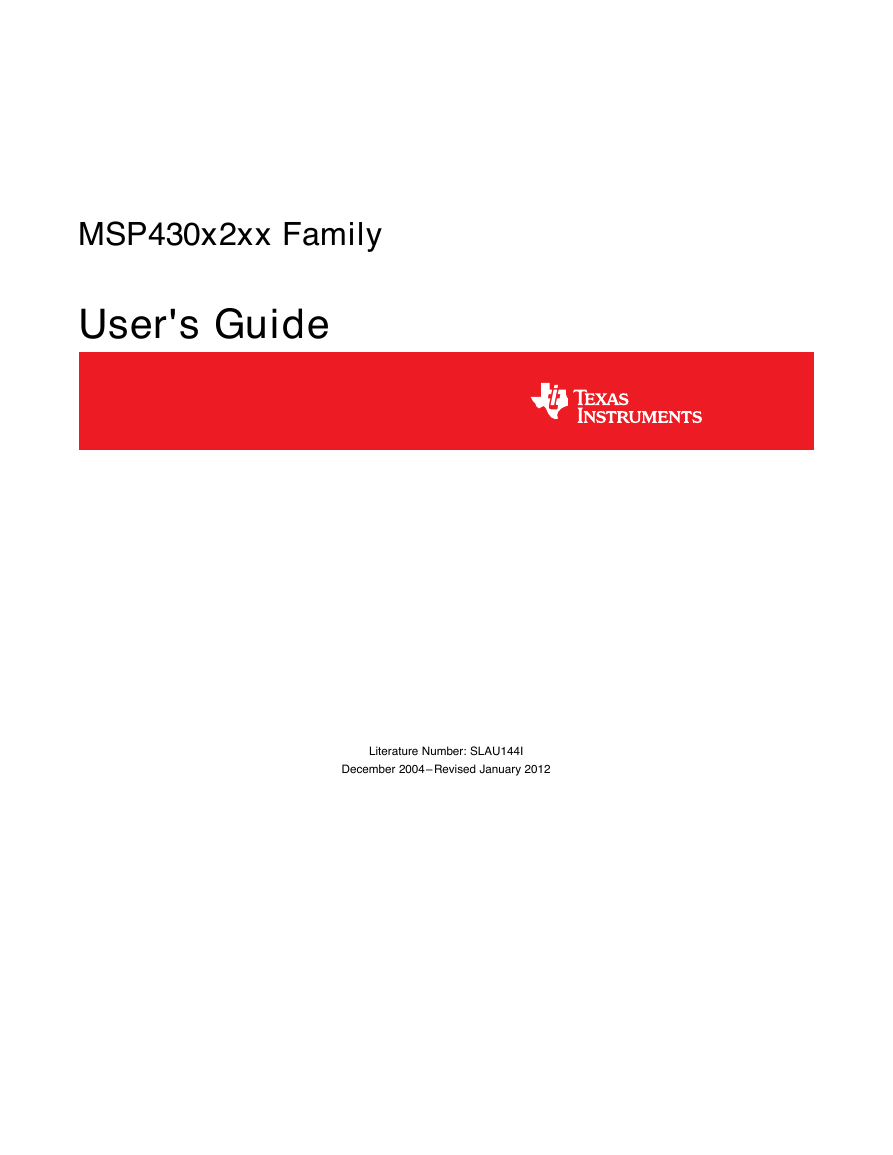

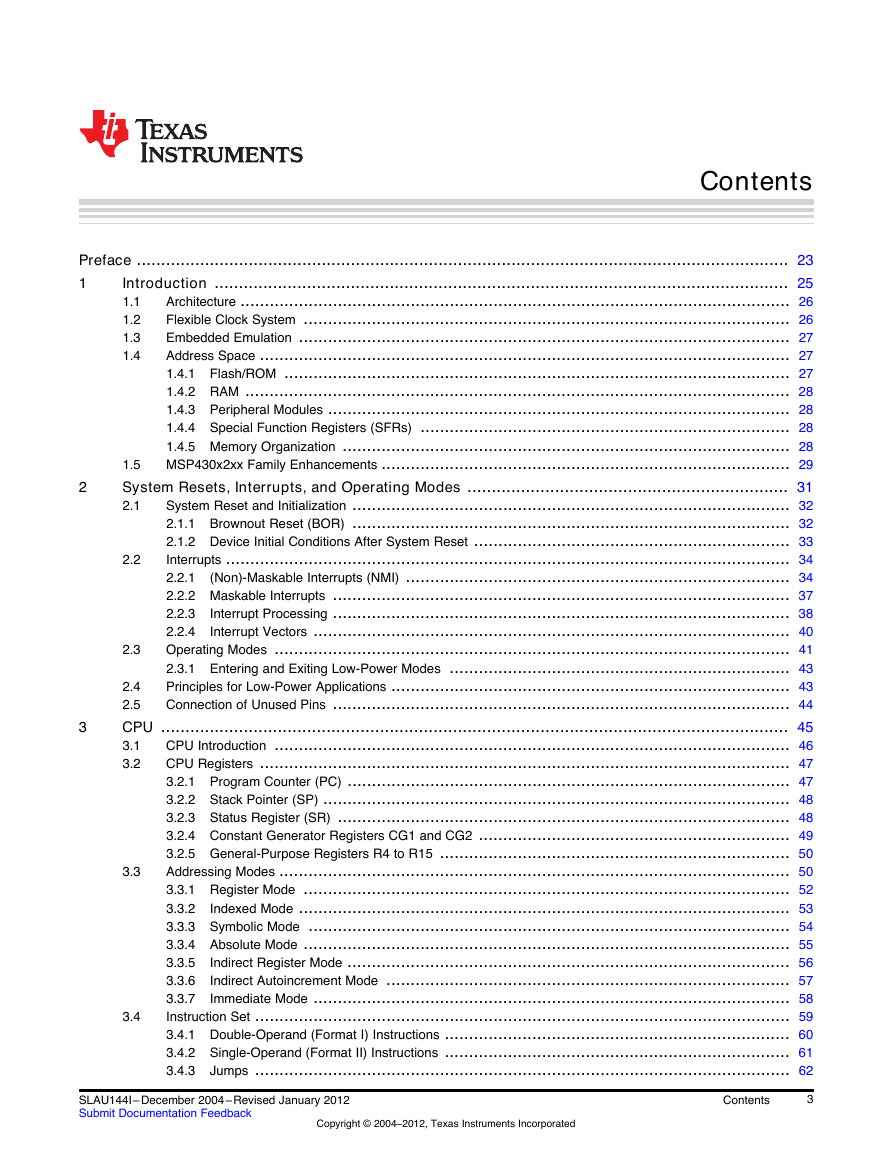
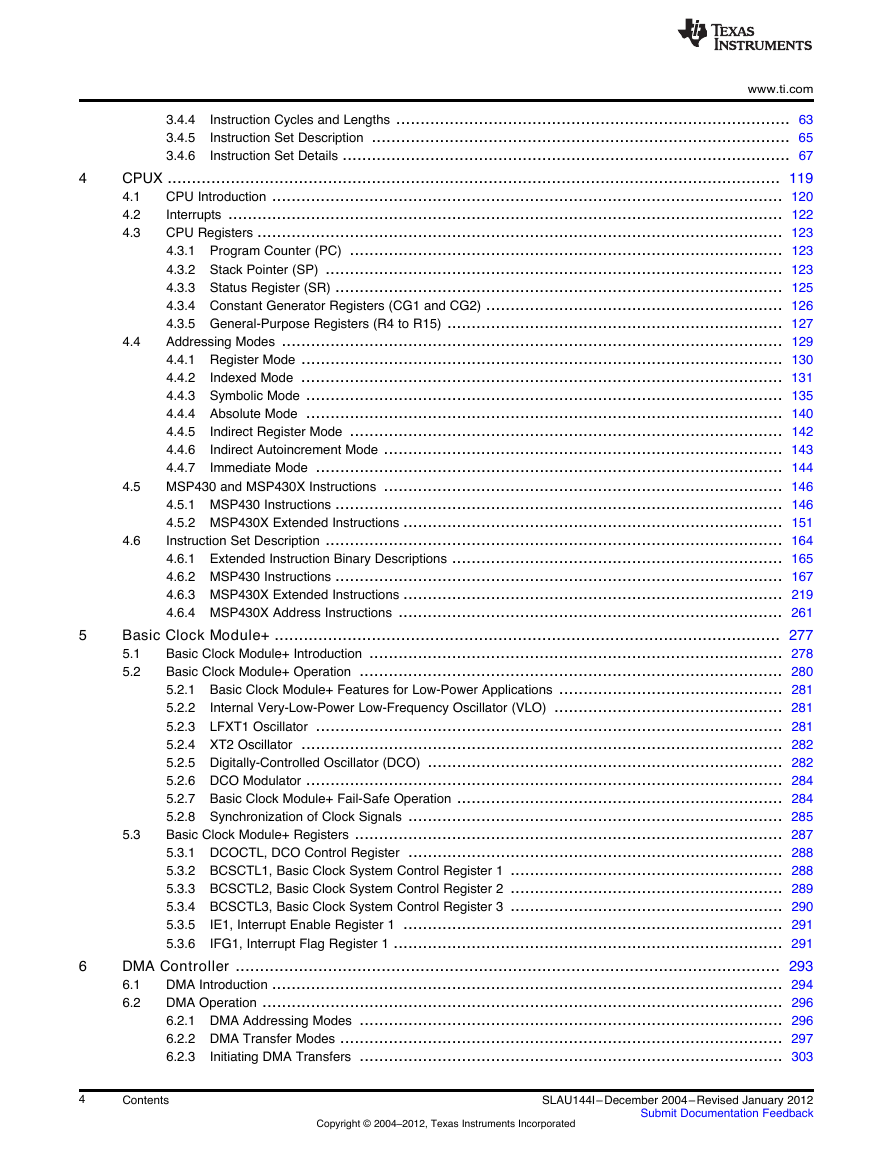

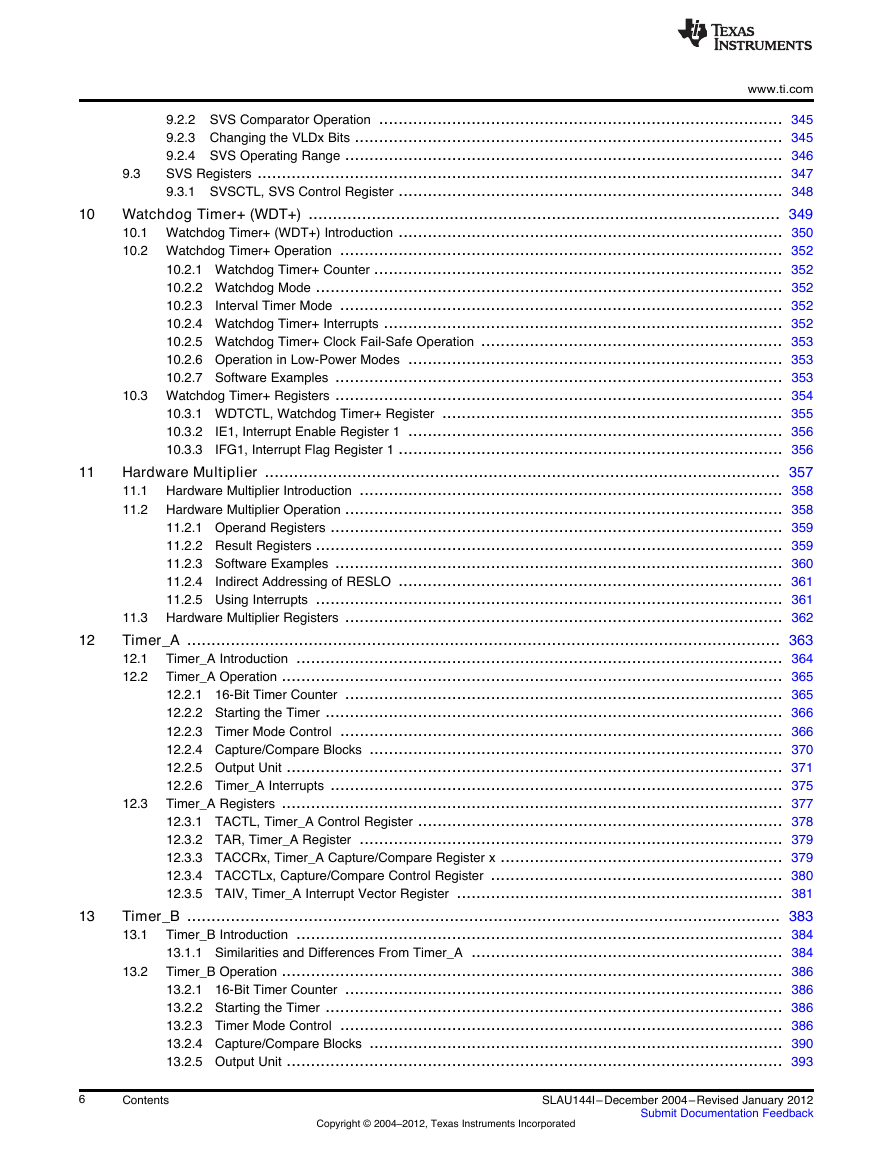
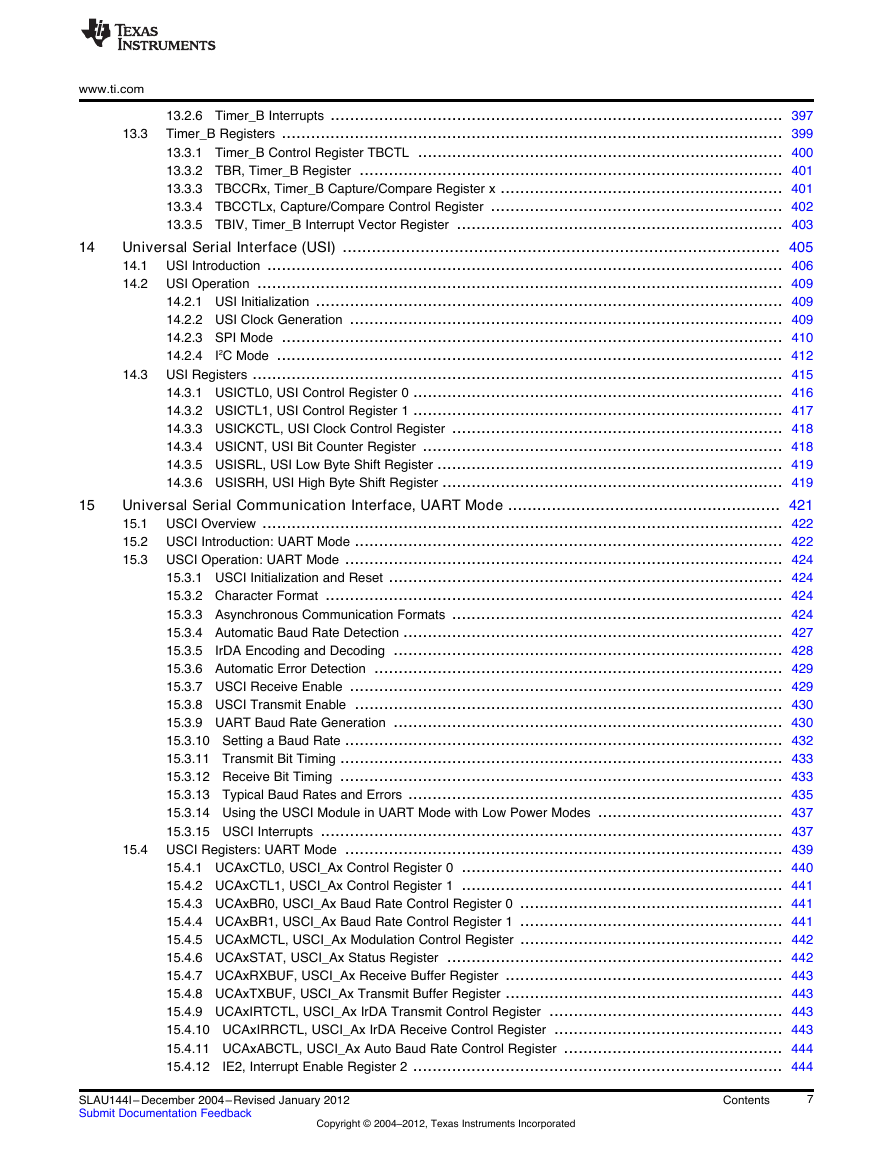









 2023年江西萍乡中考道德与法治真题及答案.doc
2023年江西萍乡中考道德与法治真题及答案.doc 2012年重庆南川中考生物真题及答案.doc
2012年重庆南川中考生物真题及答案.doc 2013年江西师范大学地理学综合及文艺理论基础考研真题.doc
2013年江西师范大学地理学综合及文艺理论基础考研真题.doc 2020年四川甘孜小升初语文真题及答案I卷.doc
2020年四川甘孜小升初语文真题及答案I卷.doc 2020年注册岩土工程师专业基础考试真题及答案.doc
2020年注册岩土工程师专业基础考试真题及答案.doc 2023-2024学年福建省厦门市九年级上学期数学月考试题及答案.doc
2023-2024学年福建省厦门市九年级上学期数学月考试题及答案.doc 2021-2022学年辽宁省沈阳市大东区九年级上学期语文期末试题及答案.doc
2021-2022学年辽宁省沈阳市大东区九年级上学期语文期末试题及答案.doc 2022-2023学年北京东城区初三第一学期物理期末试卷及答案.doc
2022-2023学年北京东城区初三第一学期物理期末试卷及答案.doc 2018上半年江西教师资格初中地理学科知识与教学能力真题及答案.doc
2018上半年江西教师资格初中地理学科知识与教学能力真题及答案.doc 2012年河北国家公务员申论考试真题及答案-省级.doc
2012年河北国家公务员申论考试真题及答案-省级.doc 2020-2021学年江苏省扬州市江都区邵樊片九年级上学期数学第一次质量检测试题及答案.doc
2020-2021学年江苏省扬州市江都区邵樊片九年级上学期数学第一次质量检测试题及答案.doc 2022下半年黑龙江教师资格证中学综合素质真题及答案.doc
2022下半年黑龙江教师资格证中学综合素质真题及答案.doc